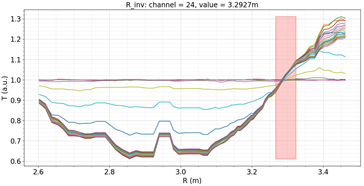DESC and JETSTA: codes to evaluate features of sawtooth crashes
B.S. Lepiavko, A.I. Tishchenko, Yu.V. Yakovenko and JET collaborators
Institute for nuclear research of NAS of Ukraine, Kyiv, Ukraine
The sawtooth crashes observed in experiments on tokamaks are known to affect the distribution of fast ions. In particular, passing ions are strongly redistributed by the crash, as well as trapped ions with energies, lower than specific value of critical energy (Ecrit) [1]. This energy depends on the spatial extent and duration of the crash. The spatial extent of the crash can be characterized by the inversion radius and the mixing radius. The former one determines the spatial separation between the areas where the temperature falls down and rises due to the crash. The latter one limits the total volume affected by the crash. Knowing all these values helps to evaluate the share of ions, affected and redistributed by the crash, and lets one perform simulations of processes in plasma, taking into consideration the sawtooth events.
Two codes have been developed to evaluate the parameters mentioned above. Both codes use electron cyclotron emission measurements on JET tokamak as the source of temperature evolution data. The code DESC (Duration Evaluation of Sawtooth Crashes) analyses temperatures at different radii, searching for the specific behavior patterns predicted by the Kadomtsev theory of magnetic reconnection [2]. JETSTA (JET Sawtooth Analysis) uses correlation approach and provides estimates by comparing correlation coefficients for different radial positions, and so it could be applied to non-Kadomtsev-type collapses or even to processes other than sawteeth, which are accompanied by significant drops of temperature.
Both codes have been applied for more than one hundred crashes, observed in experimental campaigns on JET. In the talk, a detailed comparison of two algorithms is provided. The definition of sawtooth crash from numerical point of view, application and limitations of usage are discussed.
|
|
|
Fig.1 Left panel, raw ECE data of temperature evolution with typical patterns of temperature evolution for core, medium and peripheral plasma regions. Marks show what DESC is looking for. Right panel, evaluation of inversion radius by JETSTA, based on comparison of data from many spatial locations. |
1. Ya. I. Kolesnichenko and Yu. V. Yakovenko. Nucl. Fusion 36, 159 (1996).
2. B. B. Kadomtsev, Sov. J. Plasma Phys. 1, 389 (1976).

